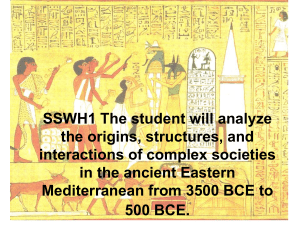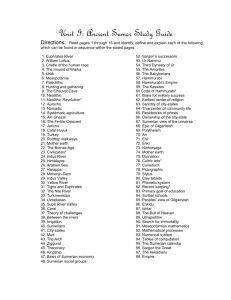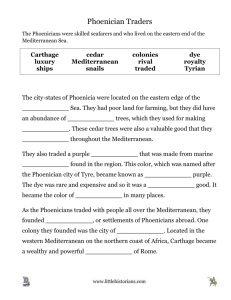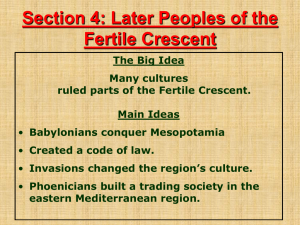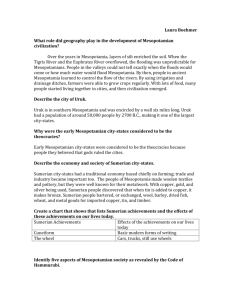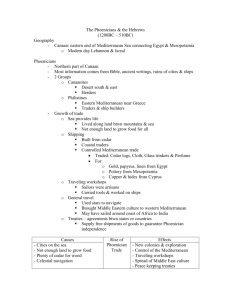Ancient Eastern Mediterranean
advertisement
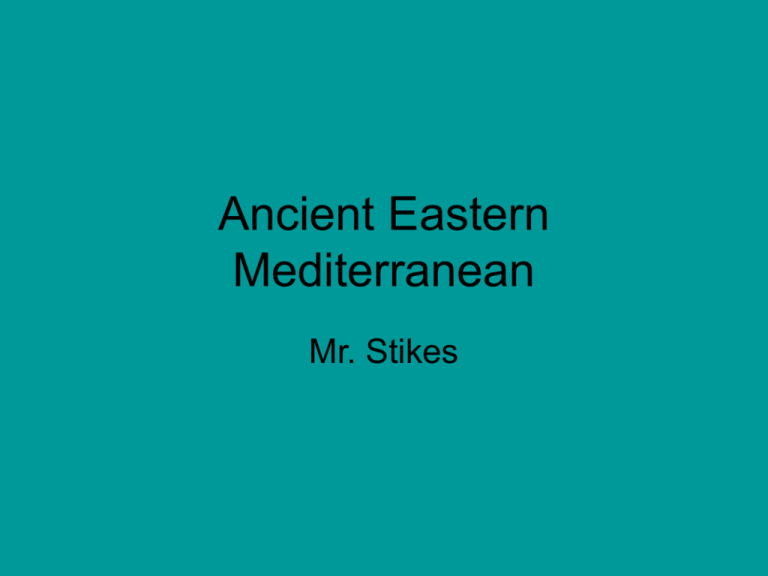
Ancient Eastern Mediterranean Mr. Stikes SSWH1 The student will analyze the origins, structures, and interactions of complex societies in the ancient Eastern Mediterranean from 3500 BCE to 500 BCE. a. Describe the development of Mesopotamian societies; include the religious, cultural, economic, and political facets of society, with attention to Hammurabi’s law code. b. Describe the relationship of religion and political authority in Ancient Egypt. c. Explain the development of monotheism; include the concepts developed by the ancient Hebrews, and Zoroastrianism. d. Describe early trading networks in the Eastern Mediterranean; include the impact Phoenicians had on the Mediterranean World. e. Explain the development and importance of writing; include cuneiform, hieroglyphics, and the Phoenician alphabet. Goal To analyze the origins, structures, and interactions of complex societies in the ancient Eastern Mediterranean from 3500 BCE to 500 BCE WHO? Who? • • • • • • • Egyptians Babylonians Sumerians Akkadians Hebrews Persians Phoenicians WHERE? The Mediterranean The Eastern Mediterranean Greece IRAQ WHEN? 3500 BCE – 500 BCE • BCE – Stands for “Before Common Era” – Equivalent to B.C. Development of Mesopotamian Societies PURPOSE OF SECTION: • Describe the development of Mesopotamian societies; include the religious, cultural, economic, and political facets of society, with attention to Hammurabi’s law code. Development of Mesopotamian Societies • How did Mesopotamian societies begin develop? – Immigration into the region • Nomads moved south from the Anatolia • Settled in Mesopotamia – “land between the rivers” Where is Mesopotamia? • Eastern Mediterranean • Between the Tigris and Euphrates Rivers Why Mesopotamia? • Fertile land for agriculture • Easy access to natural resources “Fertile Crescent” • Mesopotamia is sometimes called the Fertile Crescent • The Fertile Crescent extends to the Mediterranean Sumerian Civilization • Settled in lower portion of Tigris-Euphrates river valley • Sometimes called: – “birthplace of cities” – “cradle of civilization” Sumer • By 3000 B.C., at least twelve city-states had been founded by the Sumerians. • Cities were walled • Each worshipped an individual deity – Each had a ziggurat in the center of the city ZIGGURATS A ziggurat was a temple made of sun-dried bricks and probably decorated with colored tiles. Each was dedicated to a particular deity. Only a priest was allowed at the top of a ziggurat. Sumerian Religion • Polytheistic • Viewed deities as unpredictable • Religious ceremonies and rituals as a way to keep gods/goddesses happy • Believed in afterlife with no light/air • Important Deities: (and area of responsibility) – An – Seasons, sky – Enlil – Winds and agriculture Sumerian Government • Sumerian cities were self-governing. • Originally, a council of nobles or an assembly of citizens ran the government. • Eventually, military leaders were selected as kings. • Kingship became hereditary. • A Sumerian king was also the high priest Unification of Sumer • The Sumerian city-states were first unified by Etana, the king of the city-state of Kish, c. 2800 B.C. • In the aftermath, four major city-states (Kish, Erech, Ur and Lagash) would fight for control of all the Sumerian city-states, causing internal weaknesses. Sumerian Accomplishments • Technological Advances – Bronze – Wagon wheel – Arch – Metal Plow – Potter’s wheel – Sundial – Number system based on 60 – 12 month calendar based on cycles of moon Sumerian Accomplishments • In society – First codes of law – First city-states – Epic Poetry (Epic of Gilgamesh) – Written Language (cuneiform) Epic of Gilgamesh • • • • Epic Poem Oldest story in the world c.1850 B.C. Gilgamesh was a young king of Uruk – Epic follows his search for immortality – Contains a flood story reminiscent of the Noah in the Bible Writing • Cuneiform dates to c.3100 B.C. • Wedge-shaped markings on wet clay, which was then dried or baked until hard • Began with pictograms, but eventually developed complex symbols Akkadian Empire • Around 2300 B.C.E., Sargon I assumed power in Akkad, a city north of Sumer – According to legend, Sargon’s mother set him afloat in a reed basket shortly after his birth. He was found and raised by a farmer downstream. Akkadian Empire Akkadian Empire • Akkadians were ethnically different from Sumerians. – Akkad – Semitic • The Akkadians adopted the Sumerian religion, but kept their own language • Sargon I built the first empire in the world Babylon • The next great empire was that of the Babylonians • Hammurabi, the most famous King of Babylon, ruled from c. 1728-1686 B.C. Hammurabi’s Law Code • Hammurabi is most famous for his law code • Hammurabi created a law code of 282 laws written on 12 tablets • The laws were written in Akkadian, the language of the people Hammurabi’s Law Code • For each offense, there was a specified punishment • Hammurabi’s laws were rather harsh – Generally were “eye for an eye” • Notable Features: – Innocent until proven guilty – Able to introduce evidence to support you – Divided society into 3 social classes • Rich/Patrician • Landless Freemen • Slaves Hammurabi’s Law Code • Written on a stele (large monument of stone) and placed in the center of the city • Had picture of a god giving laws to Hammurabi, perhaps signifying that no king is above the law Conclusion • • • • Religion in Mesopotamia Economics in Mesopotamia Culture in Mesopotamia Politics in Mesopotamia Conclusion: Religion • Sumerian religion dominated the region • Polytheistic • Sense of hopelessness based on unpredictability Conclusion: Economics • Sumer was the first civilization to develop widespread, permanent agriculture • Sumer developed the first cities • In Mesopotamia, the economy depended on agriculture. Conclusion: Economics • Excess food supplies were traded to nearby peoples for metals and other natural resources • The development of cities and empires encouraged trade Conclusion: Culture • Mesopotamian society was divided: – Top – nobles – Middle – merchants, landless citizens – Bottom – slaves • Writing developed Conclusion: Politics • Sumer – Developed city-states • Akkadian Empire – Sargon I is first to establish an empire • Code of Hammurabi – – – – Influenced modern law codes “Eye for an eye” Concept of innocent until proven guilty Evidence must be presented to prove guilt Religion and Politics in Ancient Egypt PURPOSE OF SECTION: • Describe the relationship of religion and political authority in Ancient Egypt Where is Egypt? Egypt Basics • Unified first by Narmer (or Menes) • Capital at Memphis • Dynasty – a line of rulers from one family • Theocracy – government headed by religious leaders • Pharaoh – Egyptian king Egypt Basics • Organized into three periods called kingdoms: – Old Kingdom • Pyramids – Middle Kingdom • Moved capital to Thebes • Defeated by Hyksos – New Kingdom • Ramses the Great • Akhenaton and Tutankhamen Pyramids • Pyramids were tombs for Pharaohs • Writing Egypt Basics – Hieroglyphics for official works (usually carved on stone) • Hieratic for daily religious use • Demotic for daily government use – Rosetta Stone • Found by French under Napoleon • Allows us to read hieroglyphics Egyptian Politics • Pharaoh as sole ruler • Developed bureaucracy to support the central government Egyptian Religion • Polytheistic • Often represented as part human and part animal • Important deities – Ra – sun god – Osiris – god of the Nile and of all living things – Isis – wife of Osiris Egyptian Religion • Stresses the importance of the afterlife • Nile flooding was consistent, leading Egyptians to believe that the gods and goddesses were fair and could be persuaded through worship Relationship Between Religion and Politics • Pharaoh is both king and god • Religion and Politics are intertwined – Disobeying a law from Pharaoh meant disobeying a god Early Trading Civilizations of the Eastern Mediterranean PURPOSE OF SECTION: • Describe early trading networks in the Eastern Mediterranean; include the impact Phoenicians had on the Mediterranean World. • Describe other early civilizations of the Eastern Mediterranean Early Trading Civilizations of the Eastern Mediterranean • This section will cover the following trading civilizations: – – – – – – – – Hittite Aramaean Lydian Phoenician Assyrian Chaldean Persian Israelite (Hebrew) Hittites (1650 B.C. – 1200 B.C.) • First army to use iron weapons • Used chariots • Had a legal system that was less harsh than the Code of Hammurabi Arameans (1200 B.C. to 800 B.C.) • Original capital at Damascus • Decentralization followed, with provincial leaders becoming powerful • Spread their language, Aramaic, throughout the Eastern Mediterranean – Aramaic became the lingua franca (language used to communicate between people who speak different native languages) of the Eastern Mediterranean Spread of Aramaic Lydians (1200 B.C. – 546 B.C.) • Capital at Sardis • Built Temple of Artemis at Ephesus, one of the Seven Wonders of the Ancient World • Developed the concept of money – First coins were an alloy of gold and silver Phoenicians (1200 B.C. – 539 B.C.) • Developed loose confederation of city-states – Capital at Tyre • Traded throughout the Mediterranean – How did physical geography encourage trade? • Founded Carthage and Cadiz Phoenicians (1200 B.C. – 539 B.C.) • Developed the first modern alphabet – This alphabet is what most modern alphabets are based on Phoenician Alphabet A Comparison Phoenicians (1200 B.C. – 539 B.C.) • Sailed as far as Ireland to the north and Cameroon to the south • Established colonies as far away as Kerne, at the mouth of the Senegal River in Africa Probable extent of Phoenician knowledge Phoenicians (1200 B.C. – 539 B.C.) • The Phoenician city-states near Mesopotamia were conquered by Cyrus the Great in 539 B.C. • The Phoenician colonies continued to operate until much later, the greatest being Carthage Assyrians (911 B.C. – 612 B.C.) • Known for strong military – Improved upon Hittite iron weapons, used battering rams • Treated captured peoples cruelly – Depopulated areas – Enforced large indemnities Assyrians (911 B.C. – 612 B.C.) • Best known: – developing a road system connecting their empire Chaldeans (731 B.C. to 539 B.C.) • 11th dynasty of Babylonian kings • Most famous king = Nebuchadnezzar • Conquered land as far as Jerusalem – “Babylonian Captivity” was forced march of Jewish persons from Jerusalem to Babylon under the Chaldeans • Famous for Hanging Gardens of Babylon and their work in astronomy Hanging Gardens of Babylon • An elaborate park built for Nebuchadnezzar's wife • One of the original Seven Wonders of the World Persians (550 B.C. – 330 B.C.) • Under Cyrus the Great, the Persians conquered land: – As far west as Egypt, the Anatolia Peninsula and Macedonia – As far east as the Indus River – As far north as the Caucuses Mountains and into present day Afghanistan • The empire stretched over 3,000 miles and contained 50 million people Persians (550 B.C. – 330 B.C.) • Persia was divided into smaller administrative units, with each ruled by a satrap – Satraps were monitored by officials from the king called the “eyes and ears of the king” • The empire had a complex road system, improving on that of the Assyrians – one could travel to any corner in just 15 days Persians (550 B.C. – 330 B.C.) • The Persians allowed conquered peoples to keep their language and religion • Persians followed a religion called Zoroastrianism Persians (550 B.C. – 330 B.C.) • Persia was the main adversary of the Greek city-states during the Greco-Persian Wars Persian Empire at it’s Height Israelites (Hebrews) (1900 B.C. – 586 B.C.) • Traditionally descended from Abraham, from Ur – Made covenant with monotheistic Yahweh to move his family to Canaan to become new nation Israelites (Hebrews) (1900 B.C. – 586 B.C.) • Moved into Egypt, eventually as slaves • Exodus of Moses allows the Israelites to leave Egyptian captivity Israelites (Hebrews) (1900 B.C. – 586 B.C.) • Entered the period of the Judges – Judicial and military leaders – not kings • Around 1020 B.C., a monarchy led by Saul arose – David assumed the throne in 1012 B.C. & set up capital at Jerusalem – After the death of King Solomon in 922 B.C., the kingdom split into northern and southern parts Israelites (Hebrews) (1900 B.C. – 586 B.C.) • 586 B.C. – Chaldeans gain control of Jerusalem and take Israelites to Babylon – The Temple in Jerusalem is destroyed – Known as the Babylonian Captivity Israelites (Hebrews) (1900 B.C. – 586 B.C.) • 539 B.C. – The Persians under Cyrus II conquer Babylon and allow the Israelites to return to Israel – This became known as the Diaspora (“scattered” in Greek), because many of the Hebrew people did not return Conclusion • We discussed the eight major civilizations of the Eastern Mediterranean that follow the Sumerians and Egyptians. On the next slide, each civilization is listed with their most important contribution to contemporary life. Conclusion – Hittite: used iron weapons – Aramaean: Aramaic language, lingua franca of the region for generations – Lydian: Concept of money – Phoenician: Trading networks throughout the Mediterranean; First alphabet – Assyrian: Complex road system – Chaldean: Astronomy, Hanging Gardens of Babylon, “Babylonian Captivity” – Persian: large empire with religious freedom; division into smaller units – Israelite (Hebrew): Judaism Development of Writing PURPOSE OF SECTION: • Explain the development and importance of writing; include cuneiform, hieroglyphics, and the Phoenician alphabet. Development of Writing Picture writing Pictograms h & Word writing Abcd Sound-based writing Syllables Japanese Katakana Abdg Alphabet Sumerian Cuneiform • Pictograms • Use dates from ≈ 3000 B.C. to 500 B.C. – Use predates Egyptian Hieroglyphics Egyptian Hieroglyphics • Pictograms • Use dates from ≈ 3000 B.C. to A.D. 394 • Deciphered by Jean-Francois Champollion in 1822 Cuneiform v. Hieroglyphics • Not related • Similar in that they are both originally pictographical – Both develop symbols for non-tangible words Phoenician Alphabet • Developed between 1700 B.C. and 1500 B.C. • Influenced by Egyptian hieroglyphics Question to Think About… Why is writing important? Monotheism PURPOSE OF SECTION: • Explain the development of monotheism; include the concepts developed by the ancient Hebrews, and Zoroastrianism. Monotheism • Monotheism: – Belief in one god Origin of Monotheism • Zoroaster – Priest, worshipped a god named Ahura Mazda • Ahura Mazda is worshipped as the only god • Ahriman is opposite of Ahura Mazda – Followers have a moral choice • To do right or wrong – Right = Supportive of Ahura Mazda – Wrong = Against the wishes of Ahura Mazda – Good deeds are rewarded, bad deeds are punished • People have only themselves to blame for their position in life – Holy book is called the Avesta Hebrew Monotheism • Judaism – One God (Yahweh, YHWH, Adonai) – Israelites as unique chosen people – Presence of covenants between Yahweh and man • • • • • Adam – Given life on earth with certain boundaries Noah – Yahweh to never destroy the human race again Abraham – Israelites will inherit a “promised land” Moses – Given the laws as written by Yahweh David – Royal dynasty to rule forever Comparison • Zoroastrianism • Judaism – Monotheistic – Monotheistic – Concept of dark v. light – Concept of good v. evil – Free will of man – Free will of man – Judgment Day – Judgment Day – Heaven and hell – Heaven, no hell – Savior to redeem world – Savior to redeem world
